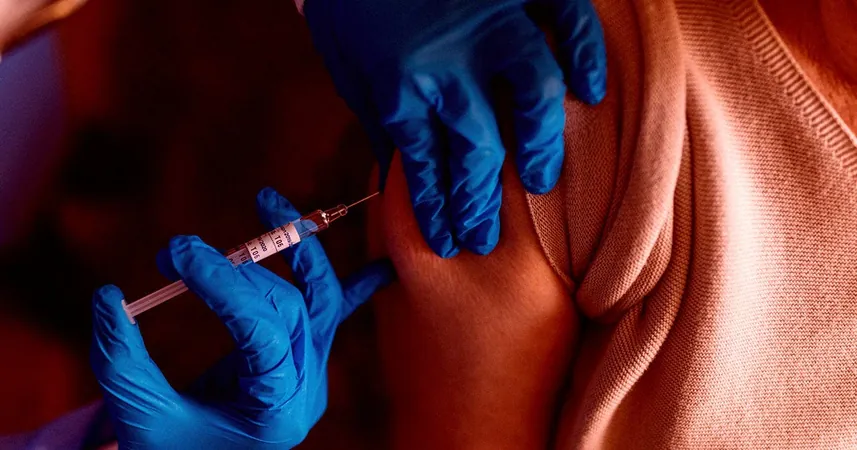
Revolutionary Hope: Can Low-Frequency rTMS Transform Treatment for Adolescent Depression?
2025-07-03
Author: Arjun
Understanding Adolescent Depression: A Growing Concern
Major depressive disorder (MDD) is rapidly becoming a leading cause of disability worldwide, particularly among adolescents. With a global lifetime prevalence of approximately 12.9%, this psychiatric condition often strikes during the crucial teenage years. In Sweden alone, 11.4% of adolescents report experiencing MDD, startlingly with 22% voicing serious suicidal thoughts. Early-onset depression is not just a phase; it frequently leads to severe repercussions such as poor academic performance, relationship issues, and potential substance abuse—impacts that can linger into adulthood.
The Challenge of Treatment-Resistant Depression (TRD) in Teens
Tragically, around 20% of adolescents with depression struggle with treatment-resistant depression (TRD), characterized by a lack of response to standard treatments like psychotherapy and selective serotonin reuptake inhibitors (SSRIs). There's no universal guideline on how to treat these vulnerable patients, leaving many in despair.
Enter rTMS: A Beacon of Hope?
Repetitive Transcranial Magnetic Stimulation (rTMS) is emerging as a potential game-changer for adults grappling with TRD. Its non-invasive nature, coupled with minimal side effects and the possibility of administering while the patient is awake, has piqued interest. While the exact mechanism of rTMS remains elusive, it’s believed to generate local electrical currents that can help modulate neuronal activity.
Early Investigations: Promises and Pitfalls
Most studies investigating rTMS for unipolar TRD in adolescents have been small and open-label. In a groundbreaking multi-center, double-blind trial, researchers found no notable differences in symptoms between active and sham rTMS. A recent study from China, however, suggested that high-frequency rTMS could yield encouraging results. Meanwhile, low-frequency protocols have shown promise in adults, which raises the question: could these methods work for teens?
A New Study: Testing the Waters
A recent open-label pilot study aimed to explore the feasibility, safety, and potential antidepressant efficacy of 1 Hz right hemisphere rTMS in adolescents with TRD. This unprecedented trial registered under Clinical Trials (NCT06126198) involved thorough patient screening and rigorous treatment protocols.
Participants and Protocol: What Was Done?
Twenty patients aged 13–19, suffering from unipolar or bipolar depression and having undergone prior treatments, were tracked over weeks of rTMS treatment. The rTMS sessions delivered aimed at a particular area of the right DLPFC and the protocol followed was thoughtfully designed to maximize tolerability.
Early Results: What Did They Find?
The study revealed promising yet cautious findings. While 18 out of 20 participants completed the treatment, scalp pain and headaches were the most common side effects, both of which declined over time. Although there was a significant overall reduction in depressive symptoms, only one participant achieved remission.
Limitations and the Road Ahead
While the initial results are encouraging—showing a statistically meaningful drop in depression scores—the lack of a control group and small sample size urge caution in drawing definitive conclusions. Notably, adverse events, including a suicide attempt, highlight the need for close monitoring in ongoing research.
Conclusion: Could rTMS Change Lives?
As traditional treatments fall short for many struggling adolescents, low-frequency rTMS shines as a beacon of hope. The substantial reduction in depressive symptoms, despite limited responses, suggests that further investigation is warranted. Future research should delve deeper, potentially with larger participant pools and robust control measures. Until then, rTMS remains a promising yet largely uncharted territory in the fight against adolescent depression.




 Brasil (PT)
Brasil (PT)
 Canada (EN)
Canada (EN)
 Chile (ES)
Chile (ES)
 Česko (CS)
Česko (CS)
 대한민국 (KO)
대한민국 (KO)
 España (ES)
España (ES)
 France (FR)
France (FR)
 Hong Kong (EN)
Hong Kong (EN)
 Italia (IT)
Italia (IT)
 日本 (JA)
日本 (JA)
 Magyarország (HU)
Magyarország (HU)
 Norge (NO)
Norge (NO)
 Polska (PL)
Polska (PL)
 Schweiz (DE)
Schweiz (DE)
 Singapore (EN)
Singapore (EN)
 Sverige (SV)
Sverige (SV)
 Suomi (FI)
Suomi (FI)
 Türkiye (TR)
Türkiye (TR)
 الإمارات العربية المتحدة (AR)
الإمارات العربية المتحدة (AR)